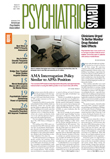If the American public were asked to give an example of adult separation anxiety disorder, they might cite the classic Hollywood film“ Casablanca,” where Ilsa (Ingrid Bergman) clings to Rick (Humphrey Bogart) shortly before they part forever. Or they might point to the Hollywood thriller “Psycho,” where lead character Norman Bates (Anthony Perkins) sleeps next to his mother long after she has died.
Adult separation anxiety disorder is more than the stuff of Hollywood, though. It afflicts some 7 percent of Americans at some point in their lives, according to a new study.
“The results did not really surprise me,” katherine Shear, M.D., a professor of psychiatry at Columbia University and the lead investigator, told Psychiatric News. “Our group in Pittsburgh, as well as colleagues in Australia and in Italy, have observed adult separation anxiety disorder in clinical populations for a number of years now. It is clear that this is an identifiable syndrome.”
The investigation conducted by Shear and her colleagues appears to be the first to explore the prevalence of adult separation anxiety disorder in the American population. Data for the inquiry were collected as part of the National Comorbidity Survey Replication, which has already provided a treasure trove of information about the prevalence and treatment of psychiatric disorders (Psychiatric News, July 1 and July 15, 2005).
Still other notable insights into adult separation anxiety disorder have emerged from the study by Shear and her team. For example, the prevalence of the disorder in the United States is even greater than that of childhood separation anxiety disorder, which is 4 percent. While some Americans with the adult version first experienced it during childhood, the vast majority encountered it once they reached adulthood. Adult separation anxiety disorder often occurs along with other psychiatric illnesses, especially other anxiety conditions or mood disorders.
Further, adult separation anxiety disorder is often associated with personal and social impairment—many Americans with it are poorly educated, unemployed, and unmarried—even when other psychiatric illnesses are not present. And while 75 percent of Americans with the condition are receiving treatment, most are receiving help for comorbid conditions rather than for separation anxiety per se.
These results have implications for clinical psychiatrists, Shear believes.“ They need to be aware of the occurrence, prevalence, and comorbidities of this syndrome, which could be confused with agoraphobia and which could complicate another Axis I disorder, since it is co-occurring with so many. Following the principle of measurement-based care, it will be very important to follow these symptoms in patients who are treated for adult separation anxiety and/or co-occurring conditions.”
Even with the insights obtained from this study, a lot more needs to be learned about adult separation anxiety disorder, Shear and her group pointed out in their study report, which appeared in the June American Journal of Psychiatry.
For instance, when is the dependence of family members on each other culturally determined and acceptable, and when is it pathological? When is angst about separation from a loved one during war, natural catastrophes, or other dire circumstances to be expected, and when is it not? And what are normal and abnormal responses to the loss of a loved one? Shear, in fact, is exploring these issues (Psychiatric News, August 20, 2004; July 15, 2005).
The study by Shear and her team was financed by the National Institute of Mental Health, John D. and Catherine T. MacArthur Foundation, Pfizer Foundation, U.S. Public Health Service, Pan American Health Organization, Eli Lilly and Co., and GlaxoSmithkline.
